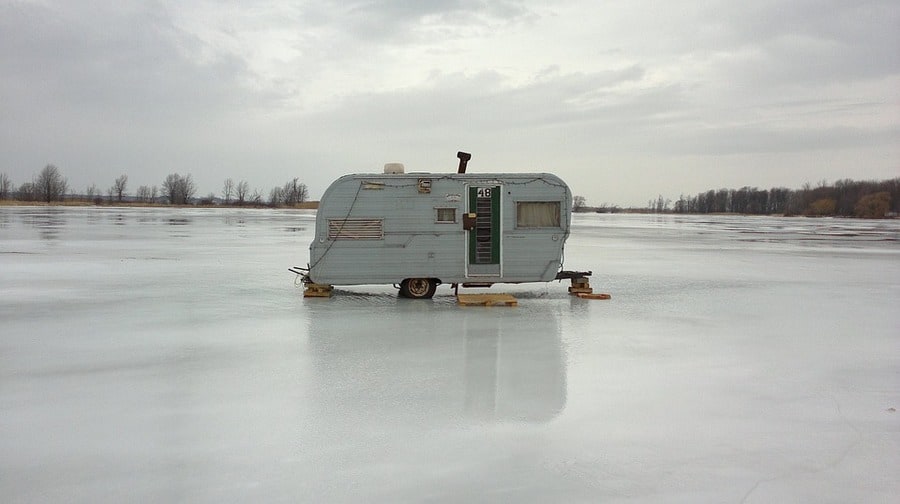Ice Fishing Rattle Reels Explained: Do They Catch Fish?

Leave a comment after this article and let’s talk more about fishing. I’d love to read your feedback.
For many ice fishermen, a rattle reel is a foreign concept and I know for myself, it was something I had never heard of until I got to try one a few years back. I grew up jigging shallow while I watched my lineup of tip-ups strewn across the lake. But rattle reels are popular among a lot of anglers and it is a topic worth investigating.
What is a rattle reel for ice fishing and does it catch fish? A rattle reel is a specially designed reel that attaches to the side of a wheelhouse, ice shanty, or even a bucket and is meant for ice fishing a suspended bait and it can be very good for catching fish.
They are similar to tip-ups in how they are fished however you are audibly alerted to a fish bite by a rattle that goes off when lines is quickly stripped from the reel. They are a different means to catch fish but they definitely work and are trusted by a lot of ice fishermen.
Find out how to place ice fishing holes for the best results.
Why a Rattle Reel?
Rattle reels can seem gimmicky but they can catch a lot of fish. These reels are great for distracted ice fishermen wrangling kids or occupied doing other tasks.
They are also great for fishing while you sleep as the high-pitched rattling will wake up even the deepest of sleepers as a fish strips line.
A lot of folks with wheelhouses attach at least one rattle reel so they can try to land that big walleye or catfish while they hang out or sleep.
There are a lot of great rattle reels on the market, but this model is the best-selling model (available at Amazon) because of its loud rattle, ease-of-use, and durability. They are a worthwhile tool to use and won’t cost you much at all.
Click here to learn all about ice fishing tents and huts. You may also be interested in how to catch fish with noodle rods.
High Pitched vs. Low-Pitched
Rattle reels come in all shapes and sizes. They also come in differing rattling sounds too. Some rattle reels have high-pitched rattles as they contain ball-bearings made of glass. I prefer lower-pitched rattle reels with metal ball bearings as they are louder but softer on the ears.
High-pitched ones are just annoying to operate and fight a fish. You have to remember, that reel will be rattling the whole time you are fishing a fish. If you have a pike or big walleye on, you could be looking at a minute + of hearing that rattle as that fish runs.
Loud Rattling: Both Good and Annoying
The loud rattling of a rattle reel is good for fishing because the noise is unmistakably a fish biting. The noise can be enough to wake you out of deep sleep but also to alert you when you are distracted wrangling kids or deep in thought and daydreaming.
That said, the rattle can be really annoying to as you are fighting the fish and hearing that rattle the whole fight. I am more of a tip-up and jigging kind of ice fishermen. I don’t like hearing a rattle but I know a lot of anglers who do.
Ideal Baits to Use with Rattle Reel
I recommend using a lively attractive bait that will draw in fish and entice them to bite. Remember, you bait will suspend there by itself unlike with jigging. You need to use a bait that fish want to eat. Minnows, shiners, dead cut bait, worms, waxworms, mealworms, and corn kernels are baits that can work really well with rattle reels.
Best Species to Use Rattle Reel For?
Most rattle reel anglers are targeting bigger fish like walleye, pike, bass, and catfish. You can target panfish and smaller trout on a rattle reel but you will need to downsize your bait. With bigger species as the target, you can rig on a lively golden shiner, sucker minnow, or a dead sucker for catfish.
5 Tips for Fishing Success Using a Rattle Reel
1. Use Fluorocarbon as Leader
I strongly recommend using a fluorocarbon leader attached to your ice fishing braid on the rattle reel. You can get away with straight braid to the hook but that will be more visible to fish.
A lot of anglers go with a mono leader but I don’t like the stretch of mono or the memory that retains the kinks in the line. Mono also floats so keeping your bait down could be harder.
Fluorocarbon stretches a lot less than mono, won’t have as much memory, and naturally sinks. Furthermore, fluorocarbon is razor-thin and much harder for fish to spot than braid or mono. I want you to check out the article I wrote explaining mono vs. braid vs. fluorocarbon and which lines shine under different fishing situations.
2. Select Lively Bait

Unlike jigging when you can trigger fish to bite and draw fish in by wiggling and twitching your bait, with a rattle reel, the bait alone has to draw in fish.
Just like with tip-ups, the bait will just suspend beneath the ice and it is up to the bait to make the magic happen.
I recommend using live shiners, minnows, or salamanders to really draw in big fish. If you are fishing in a state where live bait fish are illegal as bait, go with dead fish, cut fish, or even mealworms.
You can also try Berkley Gulp! Minnows as they can catch fish both jigging and on a rattle reel. They also work really well for soft-water summer fishing too.
3. Use Ice Fishing Main Line
You can use typical braid or other fishing lines for the mainline on a rattle reel and be fine but if you want to take your game to the next level, go with specially designed ice fishing braid as your mainline.
When you are hand-lining your weight from the bottom, and that line is collecting on the ice, it can become are matted.
Specially designed ice fishing braid won’t matt up like that and will be much smoother to reel onto your rattle reel and lower into the water without kinks. Ice fishing braid will cost a little more much but I feel it is worth the extra cost.
4. Experiment with LED Fishing Lights
Glow fishing lights can be an awesome thing to experiment with. The idea of placing green LED lights under the ice can seem strange, but trust me, it will draw in fish. The glow lights are fantastic for ice fishing and can turn a day with 2 fish caught into a day with 30 fish caught.
Fishing lights really shine after dark but can be really good for daytime fishing, especially on cloudy days with minimal sunshine. Glow lights work by attracting small microorganisms like plankton to the light which will draw in hungry baitfish.
Bigger fish like perch, bluegill, catfish, bass, and pickerel will follow suit both attracted to the baitfish and to the novelty of the light itself. The trick with LED fishing lights is picking a good location and then patience.
Small fish will arrive first and the longer you wait, you start seeing progressively more and larger fish. Fish will be attracted to the light and start coming in waves. The beauty of using lights is fish will keep coming throughout the night instead of you having to hole-hop to locate fish.
There are countless awesome LED fishing lights on the market but I think these are great and priced very affordably at Amazon. You will need a 12V battery though so make sure you pick one up as well. These are great for drawing in fish to your rattle reel set-up.
5. Select Fishing Location Carefully
When ice fishing with a wheelhouse or a fishing shanty, picking the right location can make a huge difference. Your fishing will be as good as the location you set up on. If you pick a shallow flat without weeds, you probably won’t catch many fish.
Likewise, a deep channel in the main body without any rock will probably also be barren. Look for winter fish-holding spots.
Look for deeper holes near the mouths of streams or fingers in a reservoir, look for hard rock in deeper water, look for weed edges near deeper water, and look for timber in deep water that sticks up above the ice. These are all fish-attracting locations and a great spot to set-up shop for rattle reel and general ice fishing.
Rattle Reel vs. Jigging Rod
Rattle reels are great for passively fishing while you’re busy doing other things but a jigging rod is the golden standard for ice fishing. A rattle reel is similar to a tip-up where the bait itself needs to be enticing enough to make the fish bite.
If you are jigging, you can wiggle, jig, and bounce your bait actively to entice strikes from fish. It is a more active way to fish but you will catch more fish jigging than with a rattle reel. Rattles are great when fishing with live bait for larger species like pike, walleye, and catfish.
But a jigging rod will catch you a lot more panfish, trout, and bass. I recommend you read my article on what a noodle rod is and how it can help you catch more fish on the ice.
Rattle Reel vs. Tip-Up
Rattle reels and tip-ups serve essentially the same purpose which is suspending line or dead bait beneath a hole and alerting the angler once there is a bite and a fish running off with your hook.
Rattle reels alert you which an audible rattle whereas a tip-up will raise its flag into air once bitten. I prefer using tip-ups 100% because you can use a lot more of them.
You can also cover a huge amount of water with 5 or 6 tip-ups whereas with a rattle reel, wherever your wheelhouse is, that is where your rattle reel is limited to.
I also don’t like hearing a rattle constantly buzzing as I fight a strong fish. I like hand-fighting my fish in silence. That said, rattle reels are great options for folks with a fishing hut or wheelhouse.
